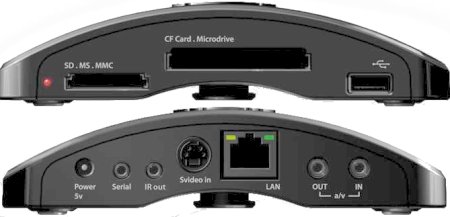Chipmaker helps sponsor Linux device software “bounties”
Apr 22, 2008 — by LinuxDevices Staff — from the LinuxDevices Archive — 1 viewsOpen Linux devicemaker Neuros Technology has pre-announced a new hardware platform based on a Texas Instruments (TI) DaVinci system-on-chip (SoC). The Linux-based “Open Internet Television HDPlatform” will use TI's TMS320DM644x SoC, with TI helping sponsor “bounties” for developers who complete key open source software projects for the platform, Neuros said.
Judging by its name, Neuros's new Open Internet Television HDPlatform (“OITH”?) may resemble the original OSD, but with the ability to output or transcode high-definition video. The OSD is a small media adapter aimed at letting users record MPEG-4 video from cable or broadcast TV, DVDs, etc., and then transfer it to portable media players via removable flash cards or USB.

Neuros OSD, front and back
(Click to enlarge)
The new OITH device will use an unspecified chip from TI's TMS320DM644x line of SoCs, which are marketed under the brand name “DaVinci.” When TI first announced DaVinci, it promised to help build software ecosystems around the parts. True to its word, the chipmaker will now participate in a “six month phased program that will release a host of bounties to build and optimize this new platform,” Neuros said.
Jason Kridner, principal architect of open platforms at TI stated, “Supporting these bounties reflects TI's commitment to involve the communities that build software.”
Mark Denissen, VP of worldwide strategic marketing at TI, stated, “TI's support for this initiative represents a significant milestone [for] open electronics.”
In an interview, Neuros Founder Joe Born commented, “It was just a few years ago that TI was asking us to take down open source code and now they are not only supporting open development, but involving the community and putting dollars into the community to do it.”
Born said he hoped the joint TI/Neuros bounty program would lead to the development of a complete Linux distribution for set-top boxes, likening the effort to projects such as Android, Maemo, and Mobile Ubuntu. “There will be a complete reference design [and] distribution, all the way to a consumer branded device that's available directly at retail to consumers. It will be a complete open platform that will allow developers of all levels to contribute and port applications. Our goal is to have a web browser so that participation using only web tools is possible,” Born said.
Neuros has previously offered several bounties for its current OSD (“open source device”) hardware design. For example, last Nov. it ponied up $3,500 for hacks enabling the OSD to be used with TiVo's web-based user interface.
Currently, Neuros lists about half a dozen projects on its bounty page. One involves porting the open source ffmpeg codec collection to TI's DaVinci architecture.
TI has previously supported Neuros's OSD development programs by offering free access to its DSP toolchain for open source application developers. Further details about the joint Neuros / TI bounty program may be available here.
This article was originally published on LinuxDevices.com and has been donated to the open source community by QuinStreet Inc. Please visit LinuxToday.com for up-to-date news and articles about Linux and open source.